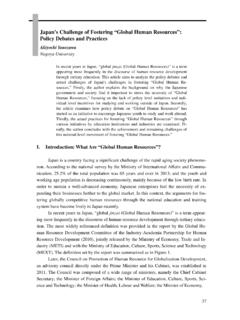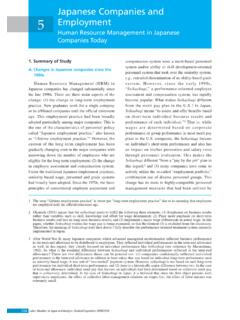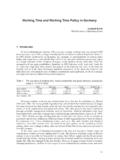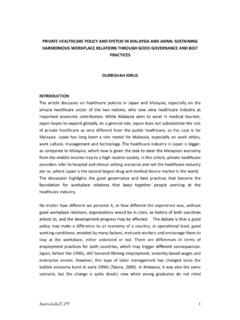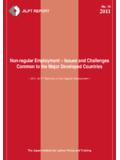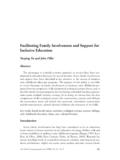Transcription of Employment Discrimination Law in Japan : Human …
1 Employment Discrimination Law in Japan : Human Rights or Employment Policy? 181 Employment Discrimination Law in Japan : Human Rights or Employment Policy? Ryoko Sakuraba Kobe University I. Introduction Every advanced country has some form of regulation to promote the Employment of racial minorities, women, older people, disabled persons and the like, who find it difficult to find Employment and suffer low wages. Their approaches, however, are not uniform. There are two types of regulations: a Human rights approach and an Employment policy approach. 1 The Human rights approach treats differences of treatment based on the prohibited grounds (ex. sex, race) as a violation of the Human rights of the individual to equal treatment. Any exception to this principle is strictly construed so as to interfere as little with the rights of individuals as possible. Preferential treatment for female workers and the like, so-called reverse Discrimination , is also considered to be against the principle of equality.
2 In contrast, the Employment policy approach uses a variety of policy instruments to support individual workers, paying attention to their different attributes, such as their age or disability2. The general principle of equality provides only protection against arbitrary Discrimination ; strict judicial scrutiny is not applied. When certain treatments based on certain grounds are regulated to attain Employment policy objectives, those regulations take on a patchwork aspect, and are realized through gradual legislative processes. Japan takes both approaches, the former for women and the latter for the elderly, disabled persons and part-time workers. It has paid subsidies to employers who hire and maintain the Employment of the elderly but enacts no comprehensive age Discrimination laws. It sets Employment quotas for disabled persons but has no disability Discrimination law.
3 Paying lower wages for part-time workers has not been illegal per se. Moreover, it can be analyzed that Japan has treated Discrimination on the grounds of belief or social status as an object of the Employment policy approach, since regulations against such Discrimination have been subordinated to the principle of freedom of contract. However, in Japan , even sex Discrimination laws have evolved from the Employment policy approach into the Human rights approach step by step over a long period. Putting this into consideration, there is a good chance that legal protection for the elderly, disabled 1 See Kazuo Sugeno, Discrimination In Employment : Dynamism And The Limits of Harmonization In Law in Roger Blanpain (ed.), I Discrimination In Employment XV World Congress of Labour Law And Social Security 5 (1998); Takashi Araki, The Impact Of Fundamental Social Rights On Japanese Law in Bob Hepple (ed.)
4 , Social And Labour Rights In A Global Context: International And Comparative Perspectives 215 (2002). 2 See Bob Hepple, Legislation Against Age Discrimination In Employment : Some Comparative Perspectives JILL Forum Special Series (2004). 8. Japan 182 persons and part-time workers to be strengthened progressively through legislative and judicial efforts on the basis of formation of social consensus and changes in Employment practices in the future. II. Constitutional Basis In the development of Japanese Employment Discrimination law after World War II, constitutional provisions on fundamental Human rights and social rights provided its basis3. The Japanese constitution promulgated in 1946 had a list of fundamental Human rights, including the guarantee of equality under the law and prohibition of Discrimination on the grounds of race, creed, sex, social status or family origin ( ).
5 Besides Human rights, the Constitution prescribes fundamental social rights. Article 27 Paragraph 1 proclaims that all people shall have the right to work and thus obliged the state to give workers suitable Employment opportunities. This objective is established in the Law of Labor Market including the Employment Measure Act (hereinafter the Measure Act ) of 1966 which proclaims the general principle of labor market policies, the Older Persons Employment Stabilization Law of 1971 (hereinafter the Older Persons Act ) and the Disabled Persons Employment Promotion Act of 1960 (hereinafter the Disabled Persons Act ). Article 27 Paragraph 2 requires the state to enact laws regulating terms and conditions of Employment . Accordingly, the Labor Standards Act (hereinafter the LSA ) was introduced in 1947. Other labor-protective legislation followed, including the Equal Employment Opportunity Act of 1985 (hereinafter the Equality Act ) which regulated Discrimination against women, the Child Care Leave Act of 1991 (amended as the Child Care and Family Care Leave Act later, hereinafter the Child Care Act ), the Act Concerning the Improvement of Employment Management, Etc.
6 Of Part-Time Workers of 1993 (hereinafter the Part-Time Act ) and so forth. Apart from these acts, general clauses of the Civil Code including abuse of rights ( ), public order ( ), tort ( ), have played an important role in the development of Japanese Employment Discrimination law. Here it is worth noting that Japanese Employment Discrimination law (defined as containing the LSA, the Older Persons Act, the Disabled Persons Act, the Equality Act and the Part-Time Act in this article) has its source not only in the equality clause ( ) but also the right to work and the obligation of states regulating terms and conditions ( and 2). This is illustrated by the fact that the principle of equal treatment was incorporated in the LSA whose basis was mainly Article 27 Paragraph 2 of the Constitution. III. Employment Discrimination Law during the Postwar Period A. The Principle of Equal Treatment in the LSA Articles 3 and 4 of the LSA of 1947 declared the principle of equal treatment applied to labor contracts as follows: (Equal Treatment) Article 3.
7 An employer shall not engage in discriminatory treatment with respect to wages, working hours or other working conditions by reason of the nationality, creed or social status of any worker. 3 Regarding the Constitutional basis of Japanese Employment and labour law, see Araki, supra note 1. Employment Discrimination Law in Japan : Human Rights or Employment Policy? 183(Principle of Equal Wages for Men and Women) Article 4. An employer shall not engage in discriminatory treatment of a woman as compared with a man with respect to wages by reason of the worker being a woman. These articles were inserted to match international standards4. They also aimed to combat major types of Discrimination which attracted social concern at that time, covering Discrimination against persons from other Asian countries, that is to say, Discrimination by reason of nationality.
8 That is why Article 3 of the LSA listed nationality instead of race, although nationality has been construed as including race by major labor scholars after The word social status was added because there had been Discrimination against persons originated from the lowest class under the feudal system. Discrimination by reason of creed was interpreted as covering Discrimination based on workers political opinions and thus unfavorable treatment against leftists, which prevailed with the influence of the red purge right after the War, became illegal. Japanese Employment equality law during the post-war era, however, had limitations with regard to its concept of Discrimination , scope of application and breadth of forbidden grounds. It can be analyzed to have started taking the Employment policy approach rather than the Human rights approach. B. Concept of Discrimination : Cases of Wage Discrimination Discriminatory treatment (dismissal, demotion and the like) in violation of the foregoing articles is nullified (LSA ).
9 When there is differentiation in wages by reason of prohibited grounds and preferred groups wages are determined by a clearly articulated rule, discriminated workers can demand equal treatment with preferred workers. Discriminatory treatment can also give rise to responsibility in damages as a tort (Civil Code ). What is difficult for discriminated workers is that they bear the burden of proof for unfavorable treatment by reason of prohibited grounds, that is to say, discriminatory intent. Japanese courts have devised the imposition of this burden on employers de facto under certain circumstances. Yet this attempt was not always successful. This point will be illustrated with reference to wage Discrimination cases. 1. General Wage Systems A brief overview of Japanese wage systems6 will help us to understand how this limit has been revealed in cases of wage Discrimination .
10 In Japan , normally, basic wages for regular workers are divided into basic wages and various allowances regularly paid. Basic wages have been decided not only by contents of jobs performed by workers; they consist of two types of wages; age/seniority-based wages that increase automatically in accordance with workers age or length of service; and skill-based wages determined under the skill-based grade system. Besides those wages, various allowances are paid according to workers personal circumstances, such as family allowances and housing allowances. In short, Japanese wage systems have had their basic idea in providing workers with the security of their life; as 4 For example, the principle of equal remuneration for men and women for equal work or equal value had been already confirmed in the 1919 Treaty of Versailles. The Declaration of Philadelphia (1944) had provided that all Human beings, irrespective of race, creed or sex, have the right to pursue both their material well-being and their spiritual development in conditions of freedom and dignity, of economic security and equal opportunity.
